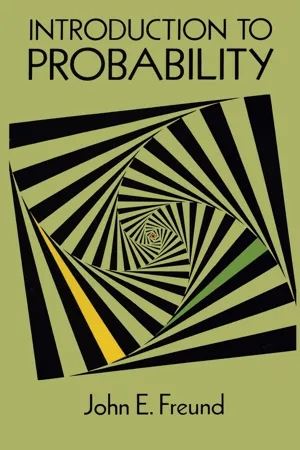![]()
1
POSSIBILITIES
INTRODUCTION
Suppose someone asked us which is more likely, that the next birthday of a person chosen at random will fall on a Monday or that the birthdays of two persons chosen at random will fall on the same day of the week. Not giving the matter much thought, we may answer quickly that the second alternative is less likely to happen because—there are so many more possibilities. Well then, let us see how many possibilities there are. In the first case, there are seven possibilities, depending on whether the person’s next birthday falls on a Monday, Tuesday, Wednesday, Thursday, Friday, Saturday, or Sunday, and of these only Monday represents a “success.” Thus, in the first case one-seventh of the outcomes are favorable. In the second case there are, indeed, more possibilities: both persons might have their birthday on a Monday, the first person might have his birthday on a Wednesday and the second person on a Tuesday, the first person might have his birthday on a Friday and the second person on a Sunday, and so on. Carefully preparing a list, we would arrive at the result that there are altogether 49 possibilities, of which seven (Monday and Monday, Tuesday and Tuesday, …, and Sunday and Sunday) provide a “success.” Thus, in the second case seven of the 49 possibilities are favorable, which is again one-seventh, and we may well conclude from this that randomly choosing a person whose next birthday falls on a Monday is as likely as choosing two persons whose birthdays fall on the same day of the week. If the reader feels that this is a foregone conclusion, or that it was obvious from the start, suppose we substitute days of the year for days of the week. Is it as likely to choose a person whose birthday is on a given day of the year, say, March 12th, as it is to choose two persons whose birthdays are on the same day of the year? The answer is “Yes,” and the argument is the same as before, but the result may not be quite so obvious.
Our example has shown how counting possibilities can go a long way toward evaluating chances. We must be careful, though, because we tacitly assumed in each case that the possibilities were all equally likely, and if this is not the case, we can run into all sorts of difficulties. Suppose, for instance, that in a baseball World Series (in which the winner is the first team to win four games) the National League champion leads the American League champion 3 games to 2. What are the chances that the American League team will nevertheless win the series? Clearly, there are the following possibilities:
(1) The National League team will win the sixth game and the series.
(2) The American League team will win the sixth game and then the National League team will win the seventh game and the series.
(3) The American League team will win the sixth game and also the seventh game to win the series.
Thus, one of the three possibilities is favorable to the American League team, which is one-third, but can we conclude from this that the chances of the American League team winning the series equal, say, those of rolling a 1 or a 2 with a balanced die (so that two of the six faces are regarded as a “success”)? The answer is “No”—even if the two teams are evenly matched—and this should be apparent from the fact that in the third case the American League team has to win two games to win the series, while in the first case the National League team has to win only one. All this goes to show that although counting possibilities may help, it does not necessarily provide the answers; very often, counting possibilities constitutes but the first step of a more detailed analysis.
In connection with the counting of possibilities there are essentially two kinds of problems, the first of which will be discussed in the section that follows, and the second in the section beginning on page 8. The first kind of problem is that of listing everything that can happen in a given situation, and even though this may give the impression of being straightforward, it is often easier said than done. It would be quite a job, for example, to list the millions of five-man committees which can be selected from among a company’s 124 employees, and even when the number of possibilities is relatively small, it can be difficult to make sure that none have been left out. The second kind of problem is that of determining how many different things can happen without actually compiling a list, and it is here that we shall learn, for example, how to arrive at the result that 225,150,024 different five-man committees can be selected from among a company’s 124 employees.
TREE DIAGRAMS
On page 3 we said that there are 49 ways in which the birthdays of two persons can fall on the various days of the week, pointing out at the time that we could arrive at this result by carefully preparing a list. Perhaps “systematically” would have been a better word than “carefully,” for proceeding systematically we find that when the first person’s birthday falls on a Monday there are seven possibilities corresponding to the second person’s birthday falling on a Monday, Tuesday, Wednesday,...
